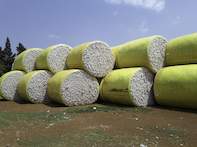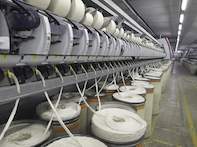After the harvesting of the cotton, the cotton bales with seed cotton are transported to a cotton mill - it is called a cotton gin or ginnery. Here, the cotton fibres are separated from the cottonseed in a process called "ginning". The gin, (short for ‘engine’) refers to the name of the machine and process during which the seed cotton is cleaned and sorted.

Once in the cotton gin, the bales of seed cotton are dried and cleaned from soil and plant material such as leaves. Then, the fibre is plucked from the seed by small circular saws. From the gin, cotton fibre and seed go separate ways.
In South Africa, the fuzzy cottonseed is mostly used for livestock feed, but where technology is available, cottonseed can be further processed to clean off the fuzzy fibres (linters), cottonseed husks removed, the oil extracted and the leftover seed-cake used for animal feed.
There are nine gins in South Africa of which the Loskop Cotton Gin near Marble Hall in Limpopo is the largest.
Processing of Cotton Lint
Separated from the cottonseed, the cleaned cotton fibre is called lint. Lint is now pressed into bales which are each tested and classed according to certain qualities. This will determine the quality and subsequently the price the cotton farmer will receive for his cotton. To determine the value of cotton, samples are taken from each bale and classed according to fibre length (staple), strength, micronaire (fibre thickness), colour and cleanness.
After processing and being tested, producers usually sell their cotton to a local buyer who sells it to a textile mill.
Cotton Textiles

At the textile mill, the cotton bales are opened and the lint is mixed and cleaned further by blowing and beating. The best fibres are about 2.5cm to 4.5cm long, so shorter lint fibres are separated and sold for use in other industries.
The long fibres go into a carding machine. This further cleans the fibres and the combing action straightens the fibres and into a soft, untwisted rope called a sliver (pronounced sly-ver). Spinning machines then spin these slivers into yarns that will be used for knitting or weaving into cotton textiles.
Woven cotton fabric is called ‘grey goods’ and will undergo processes such as bleaching, colouring and pre-shrinking before being made into clothes or homeware.
Quality of Cotton
The end use of cotton fibre is determined by its quality. The quality of cotton depends on the colour, grade, staple length, fibre strength and lint percentage.
Cotton produced in South Africa is quality tested and graded at the independent grading facilities at Cotton SA’s High-Volume Instrument (HVI) laboratory. This facility produces a quality grading certificate for each bale of cotton lint produced in the country. The services of this laboratory also support traceability and provide quality levels - to internationally recognised standards - for the local cotton industry.
It was the world’s first cotton testing facility to receive ICA Bremen Certification and the only facility in Africa with this status (2019).
By Marinda Louw